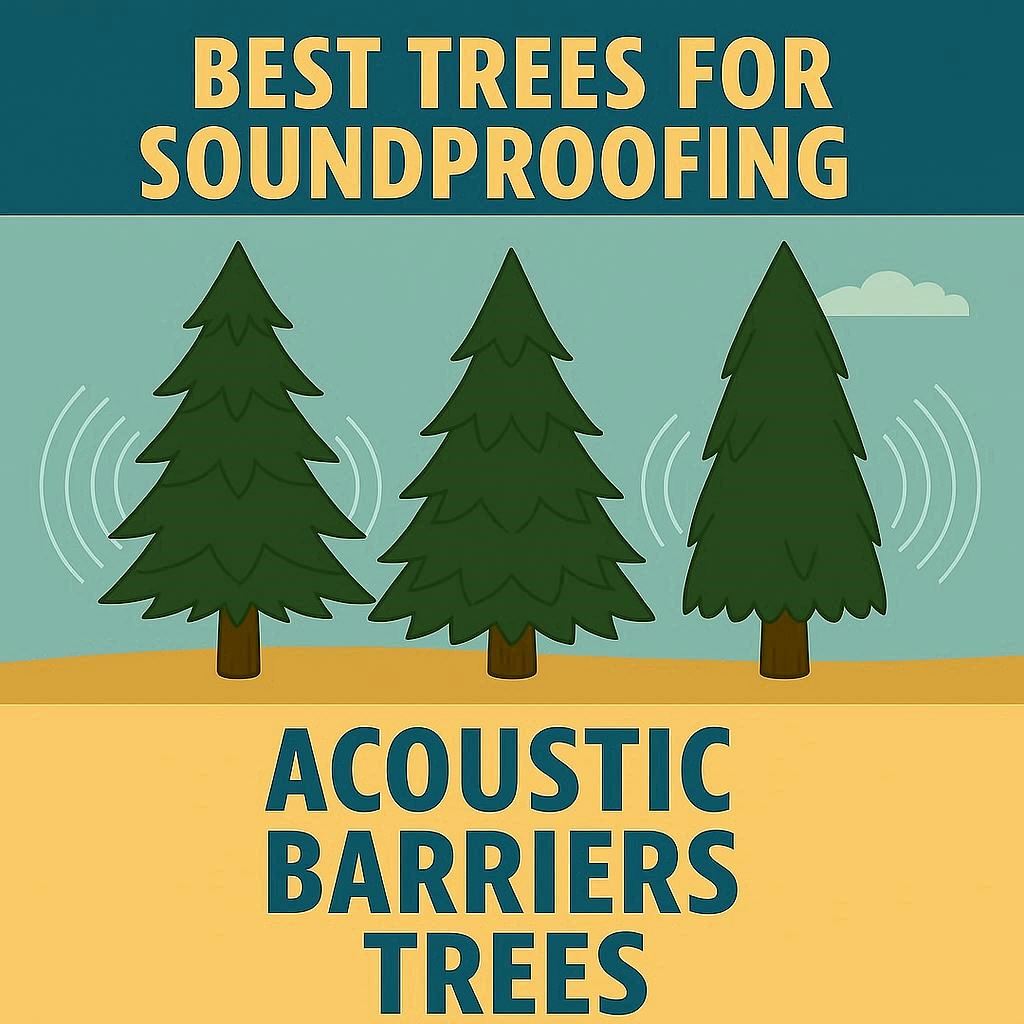
In today’s fast-paced world, peace and quiet are becoming rare luxuries. Whether you live near a busy road, have noisy neighbors, or just crave more privacy, planting sound barrier trees can make a huge difference. These trees not only reduce noise pollution but also add natural beauty, shade, and wildlife habitat to your property.
The best part? Many of these trees grow fast—some several feet a year—allowing you to enjoy results quickly. Below, we’ll explore the top 15 fast-growing sound barrier trees, their features, growth rate, soil preferences, and why each is ideal for creating a lush, green noise-reducing screen.
🌳 Why Use Trees as Sound Barriers?
Before diving into the list, let’s understand why trees are effective for sound reduction:
- Absorption: Leaves, branches, and bark absorb and scatter sound waves, reducing noise intensity.
- Deflection: Dense canopies and thick trunks deflect sound away from your home.
- Diffusion: A group of trees with staggered planting breaks up and disperses sound waves.
- Psychological Relief: Even if noise isn’t completely blocked, a dense green wall gives a feeling of seclusion and calm.
When properly planted—preferably in multiple rows and close to the noise source—trees can reduce noise by 5 to 10 decibels, which feels like cutting traffic sound by half.
🌱 Best Fast-Growing Sound Barrier Trees
Below are top species known for their rapid growth, dense foliage, and sound-buffering qualities.
1. Leyland Cypress (× Cuprocyparis leylandii)
Growth Rate: 3–4 feet per year
Height: 50–70 feet
Spread: 15–25 feet
The Leyland Cypress is one of the most popular choices for privacy and noise reduction. It grows quickly, forming a dense evergreen wall that effectively blocks sound and wind.
Why it’s great:
- Excellent year-round coverage
- Tolerates pruning and shaping
- Withstands wind and cold
Care Tips: Plant in full sun and well-drained soil. Water deeply during dry spells. Prune once or twice a year to maintain density.
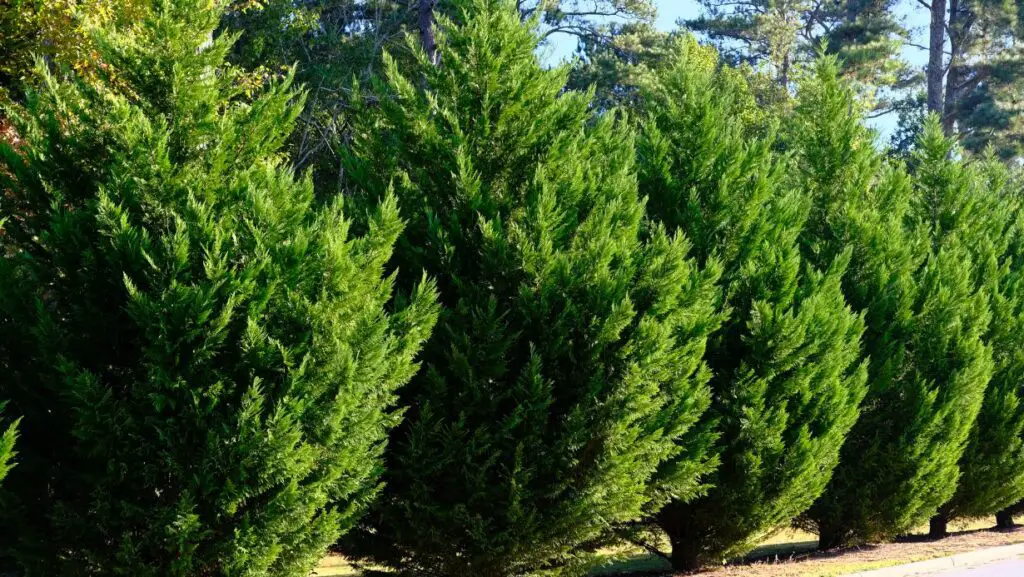
2. Thuja Green Giant (Thuja standishii × plicata)
Growth Rate: 3–5 feet per year
Height: 40–60 feet
Spread: 12–18 feet
The Thuja Green Giant is another evergreen superstar. It’s ideal for creating tall, lush hedges that double as noise barriers.
Why it’s great:
- Fastest-growing arborvitae variety
- Resistant to deer and pests
- Thrives in various soil types
Care Tips: Space trees about 5 feet apart for a dense hedge. They prefer full sun but can handle partial shade.
3. Lombardy Poplar (Populus nigra ‘Italica’)
Growth Rate: 5–6 feet per year
Height: 40–60 feet
Spread: 10–15 feet
The Lombardy Poplar grows tall and narrow, making it perfect for limited spaces. Its columnar shape helps deflect sound waves vertically rather than horizontally.
Why it’s great:
- Very fast-growing
- Ideal for long driveways or fences
- Attractive vertical silhouette
Care Tips: Best in full sun and moist, well-drained soil. Poplars have shorter lifespans (15–30 years) but are unmatched for quick results.
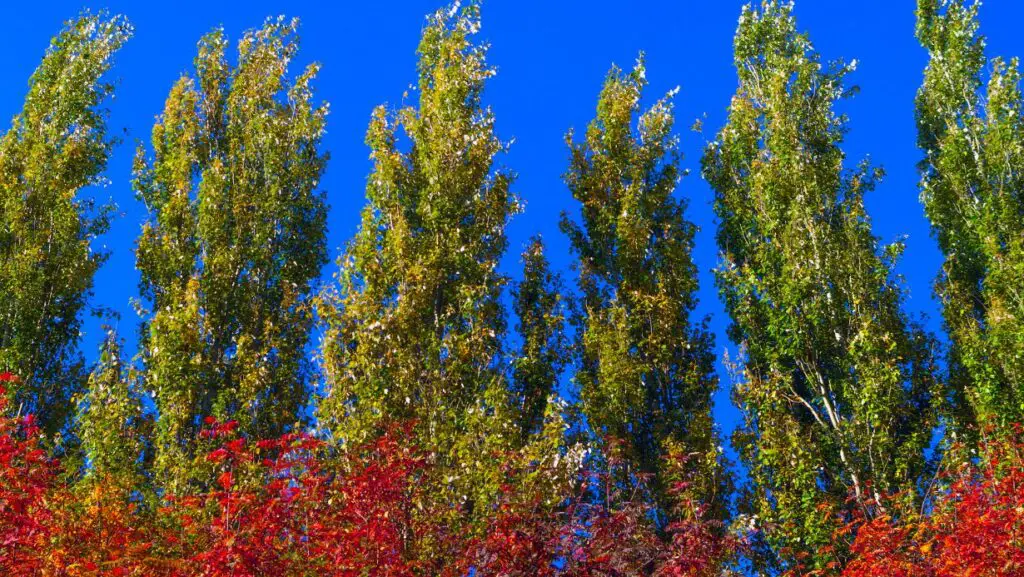
4. Eastern Red Cedar (Juniperus virginiana)
Growth Rate: 1–2 feet per year
Height: 30–60 feet
Spread: 10–20 feet
A native North American evergreen, the Eastern Red Cedar is tough and adaptable. It forms a dense, aromatic screen that muffles sound and blocks wind effectively.
Why it’s great:
- Excellent drought tolerance
- Great for rural or roadside planting
- Provides berries for birds
Care Tips: Plant in full sun. It tolerates poor soil but avoid overly wet areas.
5. Hybrid Willow (Salix × matsudana × alba)
Growth Rate: 5–8 feet per year
Height: 35–75 feet
Spread: 15–30 feet
Few trees grow faster than the Hybrid Willow. It’s ideal when you want an instant screen and noticeable noise reduction within a couple of years.
Why it’s great:
- Extremely fast growth
- Excellent wind and noise barrier
- Low-maintenance once established
Care Tips: Prefers full sun and moist soil. Regular watering during establishment ensures rapid growth.
6. Bamboo (Clumping Varieties)
Growth Rate: Up to 3–5 feet per year
Height: 10–30 feet depending on species
While technically a grass, clumping bamboo makes an outstanding sound barrier with its dense, leafy canes. Avoid “running” bamboo species unless you want it to spread uncontrollably.
Why it’s great:
- Instant green wall
- Evergreen in warm climates
- Excellent sound absorber
Care Tips: Choose clumping types like Bambusa multiplex or Fargesia. Provide ample water and sunlight.
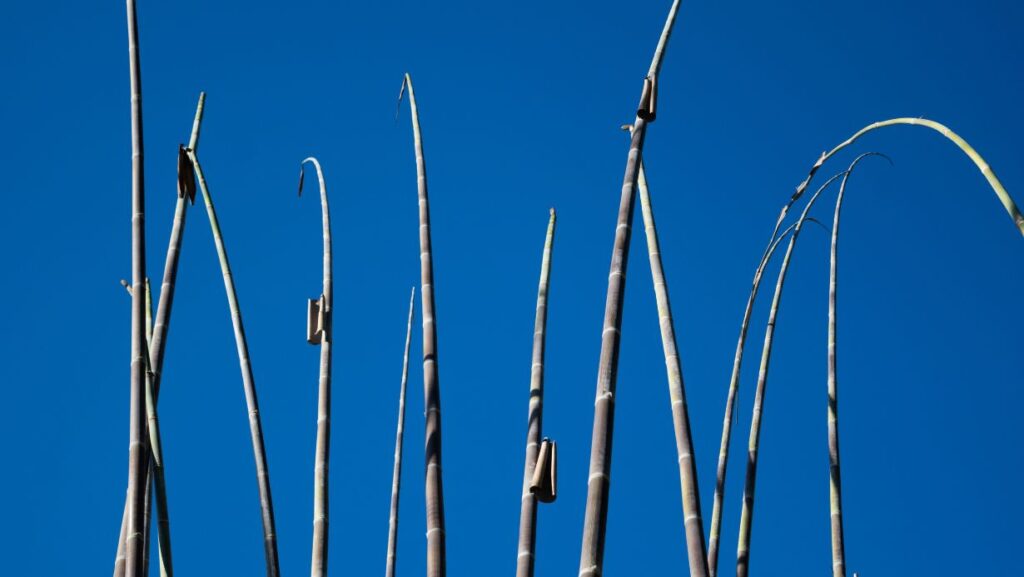
7. Silver Maple (Acer saccharinum)
Growth Rate: 3–5 feet per year
Height: 50–80 feet
Spread: 35–50 feet
Silver Maple is one of the fastest-growing deciduous trees, offering wide canopies that act as natural sound shields.
Why it’s great:
- Large, broad leaves diffuse noise
- Provides great summer shade
- Tolerates poor soil and wet conditions
Care Tips: Needs space for roots and canopy. Avoid near driveways or septic systems as roots can spread widely.
8. Red Maple (Acer rubrum)
Growth Rate: 2–3 feet per year
Height: 40–70 feet
Spread: 30–50 feet
The Red Maple is both beautiful and functional, providing vibrant fall colors and steady sound reduction.
Why it’s great:
- Fast-growing with strong structure
- Adaptable to many soil types
- Excellent fall color
Care Tips: Thrives in full sun to partial shade. Water regularly during dry spells for best growth.
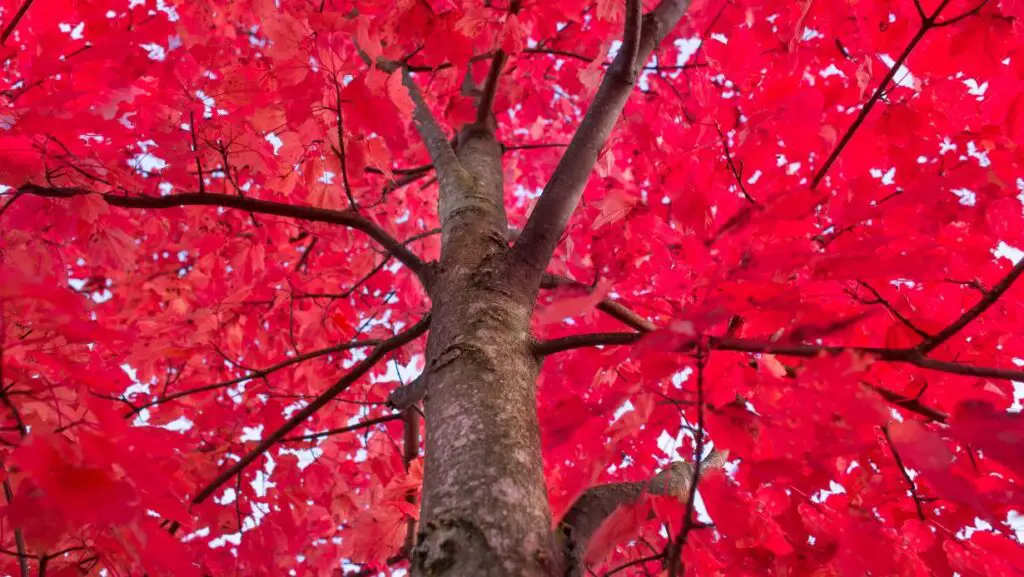
9. Norway Spruce (Picea abies)
Growth Rate: 2–3 feet per year
Height: 40–60 feet
Spread: 25–30 feet
The Norway Spruce is an evergreen with long, drooping branches that create a thick sound barrier.
Why it’s great:
- Dense and elegant appearance
- Cold-hardy and wind-resistant
- Long-lived and low-maintenance
Care Tips: Prefers full sun and well-drained soil. Avoid overly wet or compacted areas.
10. American Holly (Ilex opaca)
Growth Rate: 1–2 feet per year
Height: 15–30 feet
Spread: 10–20 feet
American Holly offers a beautiful evergreen solution with glossy leaves and red berries. It’s a moderate grower but creates a dense, sound-absorbing hedge over time.
Why it’s great:
- Year-round color and privacy
- Attracts birds
- Resistant to many pests
Care Tips: Needs acidic, well-drained soil and partial to full sun. Female trees need males nearby for berry production.
11. Nellie Stevens Holly (Ilex × ‘Nellie R. Stevens’)
Growth Rate: 2–3 feet per year
Height: 20–30 feet
Spread: 10–15 feet
This hybrid holly grows faster and denser than the native American variety. It’s an evergreen superstar for smaller yards or formal hedges.
Why it’s great:
- Fast and dense growth
- Deep green leaves year-round
- Easy to shape into hedges
Care Tips: Plant in full sun to partial shade. Tolerates clay and sandy soils with good drainage.
12. Cryptomeria (Japanese Cedar) (Cryptomeria japonica)
Growth Rate: 2–3 feet per year
Height: 50–70 feet
Spread: 20–30 feet
The Japanese Cedar is elegant and soft-textured, forming a thick evergreen wall perfect for sound reduction.
Why it’s great:
- Attractive conical shape
- Resistant to pests and diseases
- Tolerates heat and humidity
Care Tips: Thrives in full sun and moist, well-drained soil. Mulch around the base to retain moisture.
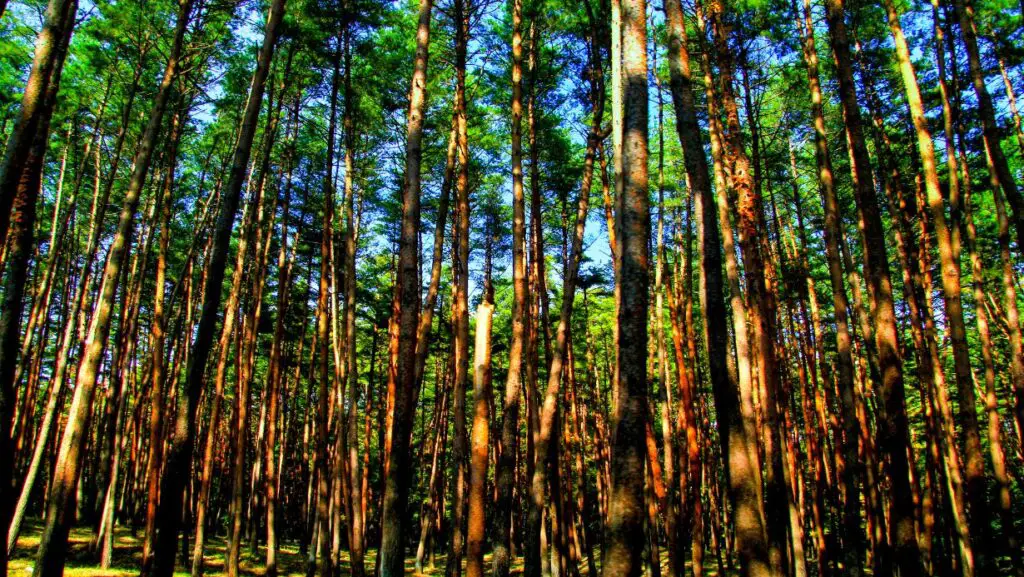
13. River Birch (Betula nigra)
Growth Rate: 2–3 feet per year
Height: 40–70 feet
Spread: 25–35 feet
The River Birch stands out for its peeling bark and adaptability to wet soils. Its dense canopy helps scatter and absorb sound waves.
Why it’s great:
- Thrives in moist or flood-prone areas
- Attractive bark adds landscape appeal
- Resistant to most pests
Care Tips: Plant in full sun to partial shade. Keep soil moist, especially during hot summers.
14. Austrian Pine (Pinus nigra)
Growth Rate: 2–3 feet per year
Height: 40–60 feet
Spread: 20–30 feet
A durable evergreen, the Austrian Pine is great for windbreaks and sound barriers. It maintains its needles year-round for consistent coverage.
Why it’s great:
- Hardy in cold and dry climates
- Thick needles absorb noise well
- Tolerant of pollution and poor soil
Care Tips: Plant in full sun with good air circulation. Avoid overly wet soil to prevent root rot.
15. Carolina Sapphire Cypress (Cupressus arizonica var. glabra ‘Carolina Sapphire’)
Growth Rate: 3–5 feet per year
Height: 30–40 feet
Spread: 15–20 feet
This striking silvery-blue evergreen grows fast and provides a soft, aromatic barrier against noise and wind.
Why it’s great:
- Stunning blue-green color
- Excellent drought tolerance
- Fast growth with minimal maintenance
Care Tips: Thrives in full sun and well-drained soil. Avoid heavy clay or poorly draining areas.
🌾 Tips for Planting a Sound Barrier
- Plant in Rows: Two or three staggered rows create the thickest and most effective sound wall.
- Mix Species: Combine fast-growing with slower but long-lived trees for lasting protection.
- Mulch and Water: Young trees need regular watering and 2–3 inches of mulch for root health.
- Prune Properly: Occasional pruning encourages thicker growth and better noise absorption.
- Consider Spacing: Too close, and trees compete; too far, and gaps form. Follow each species’ spacing guideline.
🌍 Environmental and Aesthetic Benefits
Beyond noise reduction, sound barrier trees bring numerous ecological and lifestyle benefits:
- Cleaner air by absorbing pollutants
- Habitat for birds and pollinators
- Shade and energy savings for your home
- Increased property value and privacy
- Soil erosion control and stormwater management
🌿 Final Thoughts
If you’re tired of the constant hum of traffic or neighborhood noise, planting fast-growing sound barrier trees is a natural, beautiful, and effective solution. Species like Leyland Cypress, Thuja Green Giant, and Hybrid Willow can provide results within just a few years, while others like Red Maple and Norway Spruce offer long-term durability and elegance.
By selecting the right trees for your climate and space, you can create a living wall that not only quiets your surroundings but also enhances your landscape for decades to come.
